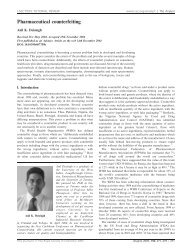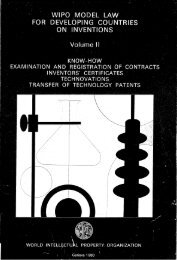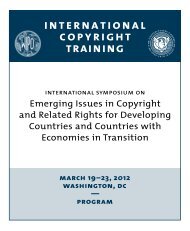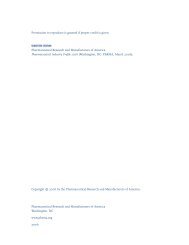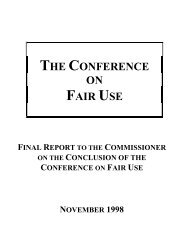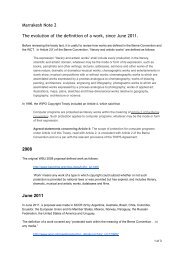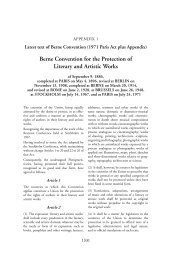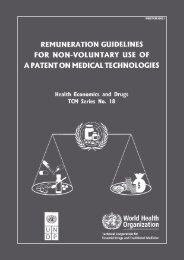how effective are prizes as incentives to innovation? evidence - Druid
how effective are prizes as incentives to innovation? evidence - Druid
how effective are prizes as incentives to innovation? evidence - Druid
- No tags were found...
Create successful ePaper yourself
Turn your PDF publications into a flip-book with our unique Google optimized e-Paper software.
other contracting systems, 3 (3) ex ante “grand <strong>prizes</strong>” <strong>to</strong> stimulate R&D. As regardsthe first two, the use of <strong>prizes</strong> is well-recognized, but <strong>prizes</strong> <strong>are</strong> not (necessarily)employed <strong>to</strong> motivate invention and <strong>innovation</strong>. The third use is the focus of thispaper. In an ex ante R&D prize system, the sponsor of the prize defines a problem <strong>to</strong>be solved, a reward for solving it, and the terms of the contest. The sponsor evaluatesthe different entries and determines the winner. The reward is often a large c<strong>as</strong>hpayment, but it may also, <strong>as</strong> in the c<strong>as</strong>e of Kremer’s (2000) analysis of theWHO/World Bank proposal, consist of credible commitments by future buyers <strong>to</strong>purch<strong>as</strong>e a given quantity of a product that satisfies specified criteria.His<strong>to</strong>rically, R&D “grand <strong>prizes</strong>” have led <strong>to</strong> important <strong>innovation</strong>s. Perhaps thebest known is the series of <strong>prizes</strong> offered in 1714 by the British government <strong>to</strong> theinven<strong>to</strong>r who could design an accurate method <strong>to</strong> me<strong>as</strong>ure longitude. Many methodswere proposed, but the <strong>to</strong>p prize of 20,000 pounds w<strong>as</strong> won by John Harrison for hischronometer (Sobel, 1995). 4 In 1775, the French Academy of Sciences offered anaward of 12,000 francs for the development of artificial alkali. Nichol<strong>as</strong> Leblancdeveloped a process using the known reaction of sulfuric acid on common salt,ultimately leading <strong>to</strong> the growth of the 19th century inorganic chemical industry. Athird important 18 th century prize stimulated the development of food canning. 5The main benefit of a prize system is <strong>to</strong> focus innovative efforts on problems forwhich solutions otherwise do not seem <strong>to</strong> be forthcoming (such <strong>as</strong> medicines for3 Here, firms compete in the pre-contractual bidding round for a procurement contract (or another typeof contract), several “winners” get a “prize,” consisting of money <strong>to</strong> develop their proposals further,and the final contract is awarded the most successful winner. Such contests allow firms <strong>to</strong> “signal” theirabilities, and thereby qualify for serious consideration. The “prize” conveys otherwise unavailableinformation about a firm’s capacity <strong>to</strong> perform R&D. A more recent, non-military, instance of such aprize w<strong>as</strong> arranged by the U.S. Department of Energy and the American Institute of Architects.Inven<strong>to</strong>rs were <strong>as</strong>ked <strong>to</strong> create a solar architectural and technological landmark <strong>to</strong> cover the south wallof the Energy Department’s building in W<strong>as</strong>hing<strong>to</strong>n, D.C. The <strong>to</strong>p prize of $20,000 w<strong>as</strong> awarded <strong>to</strong> adesign involving both hydronic and pho<strong>to</strong>voltaic solar panels <strong>to</strong> maximize the use of the sun’s energythroughout the year (Aveni, 2001).4 Most interest centered on methods <strong>to</strong> gauge longitude from the position of the stars. But JohnHarrison, an amateur clockmaker, insisted that it w<strong>as</strong> possible <strong>to</strong> design precise timepieces that, byaccurately telling the time at Greenwich, enabled a comparison with local time, and thus of the ship’slocation at sea. Over time, he developed timepieces of incre<strong>as</strong>ing accuracy, “chronometers” sufficientrobust <strong>to</strong> withstand battering at sea, yet exact enough eventually <strong>to</strong> qualify for the <strong>to</strong>p prize, according<strong>to</strong> tests by the Royal Navy.5 A prize of 12,000 francs w<strong>as</strong> offered in 1795 by Napoleon’s Society for the Encouragement ofIndustry for a method of food preservation usable by the French military. It w<strong>as</strong> awarded in 1810 <strong>to</strong>Nicol<strong>as</strong> Appert, the inven<strong>to</strong>r of food canning. The process utilized heat treatment of food in sealedchampagne bottles (Wright, 1983, p. 704).4



